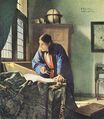Johannes Vermeer - Lady Writing a Letter with Her Maid 1670
 |
 |
 |
 |
 |
 |
 |

Lady Writing a Letter with Her Maid 1670
71x60cm oil/canvas
National Gallery of Ireland, Dublin, Ireland
The image is only being used for informational and educational purposes
<< Previous G a l l e r y Next >>
From Wikipedia, the free encyclopedia:
The work shows a middle-class woman attended by a housemaid who is presumably acting as messenger and go-between for the lady and her lover. The work is seen as a bridge between the quiet restraint and self-containment of Vermeer's work of the 1660s and his relatively cooler work of the 1670s. It may have been partly inspired by Ter Borch's painting Woman Sealing a Letter. The painting's canvas was almost certainly cut from the same bolt used for Woman with a Lute.
Lady Writing a Letter with her Maid is the first of the artist's experiments with centrifugal composition; where the focus is not only from the center of the canvas. In addition, it is his third work in which the drama and dynamic is not centered on a single figure. The maid is shown standing in the mid-ground, behind her lady, with her hands crossed and waiting for the letter to be completed. The positions of their bodies indicate that the two women are disconnected. The folded arms of the maid seem outwardly as an attempt to display a sense of self-containment, however she is detached from her lady both emotionally and psychologically. The maid's gaze towards the half-visible window indicates an inner restlessness and boredom, as she waits impatiently for the messenger to carry her lady's letter away. Some art historians dispute the absoluteness of this view; according to Pascal Bonafoux, while complicity is not "indicated by a look or a smile" from either woman, the mere fact of her presence during such an intimate act as the composition of a love letter indicates at least a degree of intimacy between the two.